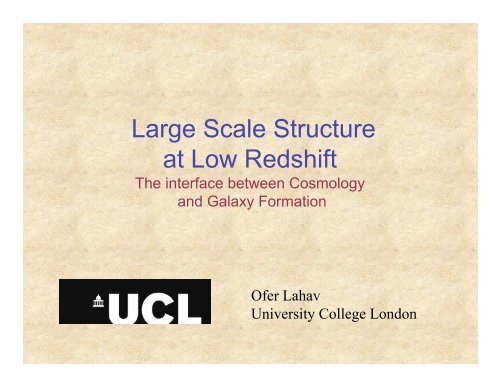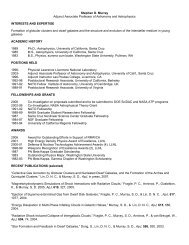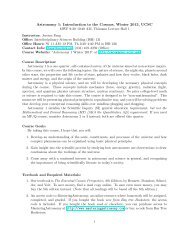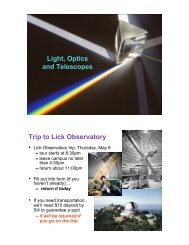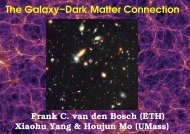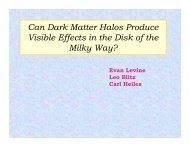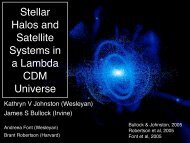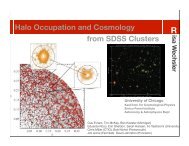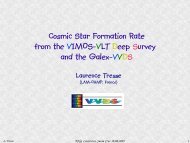You also want an ePaper? Increase the reach of your titles
YUMPU automatically turns print PDFs into web optimized ePapers that Google loves.
Large Scale Structure<br />
at Low Redshift<br />
The interface between Cosmology<br />
and Galaxy Formation<br />
<strong>Ofer</strong> <strong>Lahav</strong><br />
University College London
Redshift Surveys
LSS at low z<br />
• 2MRS/6dF The LG dipole revisited,<br />
density and velocity fields<br />
• SDSS “Baryonic” Faber-Jackson<br />
• 2dF Neutrino masses,<br />
Testing the halo model<br />
• DES Photo-z, Dark Energy<br />
“Nearly Normal Galaxies”, BFP@60, Santa Cruz, Aug 2005
Great<br />
Attractor<br />
Greatness in the Cosmic Web<br />
SDSS<br />
CfA Great Wall<br />
2dFGRS
2MASS Galactic chart<br />
F
Spectral PCA types in 2MASS<br />
62% E’s in 2MASS<br />
35% E’s in 2dF<br />
Madgwick, OL et al.
2MASS and follow-ups<br />
• 2MASS: 1.5M galaxies (K s < 13.5)<br />
• 6dF (Southern hemisphere):<br />
150K redshifts (K s < 12.75)<br />
and 15K Dn-sigma distances<br />
* 2MRS: 25K redshifts (K s
A brief history of the LG dipole<br />
• LG motion wrt to the CMB<br />
based on WMAP (1 st year)<br />
v LG = 627 +/- 22 km/sec<br />
towards<br />
(l,b) = (273 +/- 3 , 29 +/- 3) deg<br />
* IRAS dipole<br />
(Yahil, Rowan-Robinson, Davis,<br />
Strauss, …)<br />
* Optical dipole<br />
(Lynden-Bell, <strong>Lahav</strong>, Hudson,…)<br />
* Cluster dipole<br />
(Scaramella, Plionis, Tully,…)<br />
* 2MASS<br />
(Maller,…)
Dipole – weighting schemes<br />
by Number<br />
by Flux<br />
ρ L = (7.67+- 1.02) x 10 8 L_sun h Mpc -3<br />
β=Ω m 0.6 /b<br />
g / L/ (4 π r 2 )
Dipoles in the Local Group Frame<br />
Number weighed Flux weighted<br />
Erdogdu, Huchra, <strong>Lahav</strong> et al.,<br />
Astro-ph/0507166<br />
Ω m 0.6 /bL < 0.55+- 0.20<br />
15 o @ 50 Mpc/h<br />
24 o @ 130 Mpc/h
Kocevski, Mullis<br />
& Ebeling,<br />
astro-ph/0403275<br />
Dipole from X-ray clusters<br />
Shapley
2MRS Dipole directions<br />
Erdogdu et al. 2005
The expected rms bulk motion<br />
h V 2 (R *) i / Ω m 1.2 s dk P(k) W 2 (kR*)<br />
almost independent of the Cosmological Constant<br />
(<strong>Lahav</strong>, Lilje, Primack & Rees 91)<br />
Or Dark Energy (Wang & Steinhardt 98)<br />
In low density CDM smaller amplitude (σ 8 Ω m 0.6 ),<br />
larger coherence length (smaller Ω m h)<br />
than in SCDM
Wiener Filter 2MRS velocity field<br />
(CMB frame)<br />
Erdogdu<br />
et al.
The revival of peculiar velocities<br />
15,000 Dn - σ measurements out to 15,000 km/sec<br />
δσ /σ » 10%<br />
δR /R» 20%<br />
Campbell et al.
“Baryonic” Faber-Jackson relation<br />
M dyn<br />
M dyn ¼ 1.02 M star 1.03<br />
M star<br />
M star ¼ 10 11 M sun (σ/195) 4.05<br />
M star<br />
SDSS data from Bernardi et al Lintott, Ferreras, <strong>Lahav</strong><br />
σ
7 Abell clusters<br />
77 groups (>8)<br />
20 Abell clusters<br />
93 groups (>8)<br />
Baugh et al., Erdogdu et al.<br />
2dFGRS
A Nearly Normal Universe<br />
Are Dark Matter & Dark Energy<br />
the new epicycles?<br />
More components?
From 2dF+CMB (6 parameter fit):<br />
Cole et al. 2005<br />
Ω m =0.23 §0.02
Baryonic wiggles – SDSS LRG<br />
Eisenstein et al 2005.
Brief History of<br />
‘Hot Dark Matter’<br />
* 1970s : Top-down scenario with massive neutrinos (HDM) –<br />
Zeldovich Pancakes<br />
* 1980s: HDM - Problems with structure formation<br />
* 1990s: Mixed CDM (80%) + HDM (20% )<br />
* 2000s: Baryons (4%) + CDM (26%) +Lambda (70%):<br />
But now we know HDM exists!<br />
How much?
0.01<br />
0.00<br />
Weighing Neutrinos with<br />
Ω ν = 0.05<br />
Elgaroy , <strong>Lahav</strong> & 2dFGRS team,<br />
astro-ph/0204152 , PRL<br />
2dFGRS<br />
Free streaming effect:<br />
Ω ν /Ω m < 0.13<br />
Total ν mass M< 1.8 eV<br />
0.001 < Ω ν < 0.04<br />
(Oscillations) (2dF)<br />
a Four-Component<br />
Universe ?
Data<br />
2dFGRS<br />
Neutrino mass from Cosmology<br />
WMAP+2dF+…<br />
WMAP+2dFnew<br />
SDSS+WMAP<br />
Ly-α + SDSS+<br />
WMAP<br />
WMAP alone<br />
Authors<br />
Elgaroy et al. 02<br />
Spergel et al. 03<br />
Sanchez et al. 05<br />
Tegmark et al. 04<br />
Seljak et al. 04<br />
Ichikawa et al. 04<br />
All upper limits 95% CL, but different assumed priors !<br />
Mν = Σ mi < 1.8 eV<br />
< 0.7 eV<br />
< 1.2 eV<br />
< 1.7 eV<br />
< 0.4 eV<br />
< 2.0 eV
Halo model for LSS<br />
Picture credit: Cooray & Sheth (2002)
The halo model – the ‘new biasing’<br />
P(k) = P lin +P halo<br />
Truncates NFW fit with C=2.4§ 0.2<br />
Using 2dF Groups<br />
Collister & <strong>Lahav</strong>, astro-ph/0412516
Clustering of Red vs. Blue 2dF<br />
galaxies<br />
Madgwick, Hawkins, <strong>Lahav</strong> & 2dFGRS team, astro-ph/0303668
Correlation Function per Type<br />
dP / n [1+ξ(r)] dV<br />
ξ(r) = (r/r 0 ) -γ<br />
Why a power law?<br />
different slopes for blue<br />
and red explained by<br />
different halo<br />
Occupation numbers
Probing Dark Energy<br />
• Probe dark energy through the history of the expansion rate:<br />
H 2 (z) = H 2 0 [Ω M (1+z) 3 + Ω DE (1+z) 3 (1+w) ] (flat Universe)<br />
matter dark energy (constant w)<br />
P = w ρ<br />
• Comoving distance r(z) = ∫ dz/H(z)<br />
• Standard Candles d L(z) = (1+z) r(z)<br />
• Standard Rulers d A(z) = (1+z) −1 r(z)<br />
• Standard Population (volume) dV/dzdΩ = r 2 (z)/H(z)<br />
• The rate of growth of structure also determined by H(z) and by<br />
any modifications of gravity on large scales
Imaging CFHTLS<br />
Supernovae<br />
SDSS<br />
Spectroscopy<br />
SDSS<br />
Clusters AMI<br />
Surveys to measure Dark Energy<br />
2005 2010<br />
CSP<br />
CFHTLS<br />
SZA<br />
FMOS KAOS<br />
ATLAS<br />
APEX<br />
AMIBA<br />
SPT<br />
ACT<br />
CMB WMAP 2/3 WMAP 6 yr<br />
2005<br />
SUBARU<br />
ATLAS KIDS<br />
DES<br />
VISTA JDEM/<br />
Pan-STARRS<br />
SNAP<br />
DES LSST<br />
Pan-STARRS<br />
DES<br />
JDEM/<br />
SNAP<br />
Planck Planck 4yr<br />
2010<br />
LSST SKA<br />
SKA<br />
2015<br />
2015
The Dark Energy Survey<br />
300,000,000 photometric redshifts<br />
• 4 complementary techniques:<br />
* Cluster counts & clustering<br />
* Weak lensing<br />
* Galaxy angular clustering<br />
* SNe Ia distances<br />
A new 3 deg 2 camera<br />
on the CTIO Blanco 4m<br />
Construction 2005-2009<br />
Survey 2009-2014 (~525 nights)<br />
5000 deg 2 g, r, i, z<br />
Goal: error bar of few % on W=P/ρ
Input:<br />
magnitudes<br />
ANNz<br />
Collister & <strong>Lahav</strong> 2004<br />
Output:<br />
redshift
DES<br />
griz filters<br />
10σ Limiting Magnitudes<br />
g 24.6<br />
r 24.1<br />
i 24.0<br />
z 23.9<br />
Field Galaxy Photo-z Results
DES + VISTA<br />
griz+YJHKs filters<br />
10σ 10 Limiting Magnitudes<br />
Y 22.45<br />
J 22.15<br />
H 21.65<br />
Ks 21.15<br />
Field Galaxy Photo-z Results
Mock Dark Energy Survey data<br />
DES (griz) 5-yr alone DES + VISTA (YJHKs)<br />
σ z = 0.13 σ z =0.08
Conclusions - in the Trio’s own words…<br />
● “Although a spherically symmetric Great<br />
Attractor model fits the present data well…it is<br />
dangerous to use it for cosmology.” (Faber &<br />
Burstein 1988)<br />
● “CDM still does the best job, but there are many,<br />
many unresolved issues.” (Blumenthal 1987)<br />
● “The total neutrino mass could be comparable to<br />
that of the visible stars in the universe, or perhaps<br />
even larger.” (Primack 2001)


